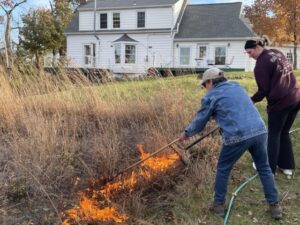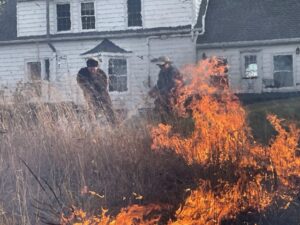On Fire?
Many readers know we burn our yard. What? Are we nuts? Fire kills. Fire destroys. Well, it can but it also cleanses and heals.
It’s one way to manage natural growth on properties. So, on a balmy early November day, we set our yard on fire! Flames towered over the yard as intense heat pushed outward.
We usually burn smallish prairies we’ve planted in both our front and back yards. Years ago, we usually burned in March but more recently we’ve shifted to November. Burning in fall seems to encourage wildflower blooms next summer.
Preparation is the Key
We’re unusual but not reckless. (A good read is at this address. www.prairienursery.com/media/pdf/burn-your-prairie-safely.pdf.) Before burning we did these things:
- Mowed a wide firebreak around our proposed burn area. Closely clipped lawns are nearly as effective as a firebreak as pavement or bare soil.
- Acquired a fire permit from Linn County Public Health.
- Found friends and neighbors to help us manage the burn.
- Ahead of time educated neighbors about the value of burning and then alerted them of our plan to burn in a certain time frame.
- Had appropriate tools on hand before we burned. These included garden rakes, matches, and both a portable fire pump, called a “Smith Indian”, and a hose stretched to the burn site.
- Workers spread flames.
- Working together.
Important Last-Minute Steps
On the day of our proposed burn, we did what the Health Department requires and first checked the air pollution report. We are only allowed to burn when the air quality is good, so jump online to a local map that shows real-time air quality. If the air quality is good, we call the sheriff’s department before burning. This is so that if someone reports smoke or fire, they know not to send out firefighters.
A light breeze helps push the fire through standing dried-out prairie grass, but too much wind can be dangerous. Our permit allows us to burn only if the wind is 20 mph or less.
Consideration of Neighbors
Because busy 30th Street Drive is our south property border we burn only when a south wind will push smoke away from the road and neighbor’s homes. North of our property is a large woodland where no one lives and there’s plenty of space for the smoke to disperse.
Rewards After Burning
Burning takes planning and preparation but the actual burn is over in a flash. On November 5th we were all ready, called the sheriff, and lit the prairie just after 3 pm. Flames roared through the grass and stopped dead when they reached our mowed lawn. Less than an hour after striking the match our fire was completely out and we were munching on pizza.
Most homeowners can’t burn, but many can. It’s an interesting and natural way to manage property. And, it’s fun.



